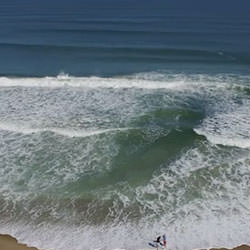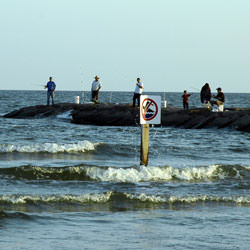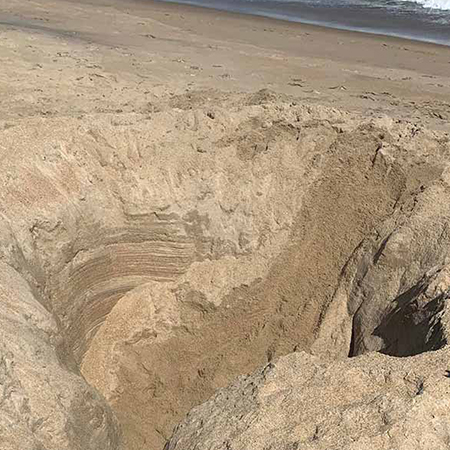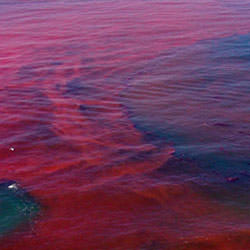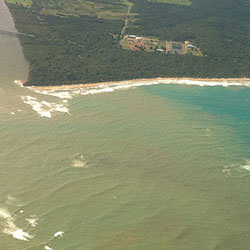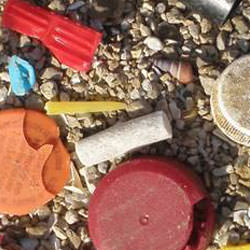Rip currents account for more than 80 percent of rescues performed by surf beach lifeguards. They are powerful, channeled currents of water flowing away from shore that quickly pull swimmers out to sea. Rip currents typically extend from the shoreline, through the surf zone, and past the line of breaking waves. The best way to stay safe is to recognize the danger of rip currents. If caught in one, don't fight it! Swim parallel to the shore and swim back to land at an angle. Always remember to swim at beaches with lifeguards.
A shorebreak is an ocean condition when waves break directly on the shore. Both small and high waves can be equally as unpredictable and dangerous and typically form when there is a rapid transition from deep to shallow water. The power of a shorebreak can cause injuries to extremities and the cervical spine. Spinal cord injuries most often occur when diving headfirst into the water or being tumbled by the force of the waves. Be sure to ask a lifeguard about the wave conditions before going into the water.
Since 2006, an average of 33 people have been killed annually by lightning in the United States. There is no safe place outside when thunderstorms are in the area. When thunder roars, go indoors! The safest places during lightning activity are substantial buildings and hard-topped vehicles. Rain shelters, small sheds, and open vehicles are not safe. Wait 30 minutes after the last thunder crack before returning to the beach.
If you take a trip to the beach, you may build sand castles or even bury yourself in the sand. These are fun activities with little-to-no danger, but digging deep holes in the sand is another matter. Digging in areas of the beach where dunes are present — especially in areas that are isolated and not visible from the beachfront — can be very dangerous. While there is no clear guidance on the depth at which these holes can become hazardous, it’s best to avoid digging holes that are deep enough for you to fall in and get stuck. (Image credit: Kill Devil Hills Fire Department)
Too much heat and sun can spoil a vacation. Heat is the leading weather-related killer in the United States, causing more deaths than floods, lightning, tornados, and hurricanes combined. Heat disorder symptoms include sunburn, heat cramps, heat exhaustion, and heat stroke. Spending the day at the beach can lead to any of these disorders but the most visible is sunburn, which can take up to 24 hours before the full damage is visible. Seek medical help right away if a burn is severe, especially if it is accompanied by a headache, chills, or fever.
Harmful Algal Blooms (HABs) (popularly referred to as red tides) are dense populations or "blooms" of algae that form in coastal waters. A small percentage of these blooms can be toxic to marine animals and humans. People can get sick by swimming directly in the water and by eating contaminated shellfish. If a sufficient amount of toxins are ingested, the results can be fatal. Scientists can forecast the timing and location of blooms. This allows coastal managers and public health officials to make decisions regarding shellfish harvesting and beach closures to ensure the health of both residents and visitors.
Coastal beaches are among the most treasured natural resources in the nation, but beach closures or advisories caused by poor water quality often prevent the public from enjoying these resources. As water flows from land to coastal waters, it is often contaminated by untreated sewage from boats, pets, failing septic systems, fertilizers, and spills from hazardous substances. High levels of bacteria and other chemicals in the water can cause gastrointestinal illnesses in those who swim directly in the water. When visiting the beach, be aware of all beach closures and advisories.
Our oceans are filled with items that do not belong there. Huge amounts of consumer plastics, metals, rubber, paper, textiles, derelict fishing gear, vessels, and other lost or discarded items enter the marine environment every day, making marine debris one of the most widespread pollution problems facing the world's oceans and waterways. This debris, or litter, often ends up on our beaches, damaging habitats, harming wildlife, and making it unsafe for beachgoers to walk along the shoreline and swim in the water.
Shark attacks, though rare, are most likely to occur near shore, typically inshore of a sandbar or between sandbars, where sharks can become trapped by low tide, and near steep drop-offs where sharks' prey gather. The relative risk of a shark attack is very small but should always be minimized whenever possible. To reduce your risk, don’t swim too far from shore, stay in groups, avoid being in the water during darkness or twilight, don't go in the water if you are bleeding from a wound, leave shiny jewelry at home, and avoid brightly colored swimwear.
Keep an eye out for jellyfish. All jellyfish sting, but not all have venom that hurts humans. Of the 2,000 species of jellyfish, only about 70 seriously harm or may occasionally kill people. When on the beach, take note of jellyfish warning signs. Be careful around jellies washed up on the sand as some still sting if their tentacles are wet. Tentacles torn off a jellyfish can sting, too. If you are stung, don't rinse with water, which could release more poison. Lifeguards usually give first aid for stings. See a doctor if you have an allergic reaction.
